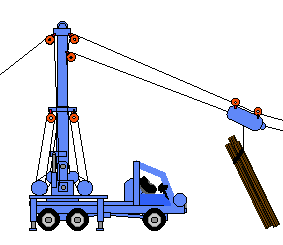Due to the small size and simplicity of these units this is where I have most of my knowledge. I guess the place to begin would be the power unit. Most of these run somewhere around 40-60 horsepower usually diesel but not always. The most common transmission would be of the torque converter type. A torque is a fluid transmission that allows some slippage to occur rather than being a solid lock up such as a manual transmission, The advantage to this slippy tranny is that you can have the unit in gear and the engine at an idle with no power output occurring, as the operator increases the throttle to make the engine run faster the output shaft slowly increases power as well, until eventually there is enough power being applied to move the object you are hooked to. This makes for great control of what you are trying to do. The disadvantage to this is that a lot of your initial horsepower is lost through the fluid transfer and heat buildup that occurs inside of the torque.
The manual transmission applies almost 100% of the input power to the output shaft, though the disadvantage here is that you have almost no control over what it is you are pulling on, other than speed via the throttle. For example when your car is parked on a hill, with an automatic tranny you can sit there for quite a while holding yourself in one spot using the gas pedal with very little negative effects to your drive train, if you tried that with a manual tranny you would certainly burn up your clutch with in a few minutes. The next type of coupler, which seems to be the newest type, is the hydraulic/hydrostatic drive. This offers very good control over power and speed applied. The design is an engine running a hydraulic pump and then hooked to a hydraulic motor to run your drums. The disadvantages here are that in this configuration you usually only have one speed (one gear) unlike the previous which can have up to 8 speeds to choose from, and there is a lot of heat involved with a totally fluid system, heat is energy and it is taking away from your output power to create that heat.
The next topic would be the drums; these are the round wheel looking things the cable is wrapped around. Nothing too complicated really, they are supported on both sides by bearing's being coupled on one side to the transmission and on the other to their individual brake. The 2 most common types of brakes would be the disc brake and band brakes. At this time I am not sure which is the better one of the two, any ideas? But one thing is that they are commonly water cooled and vented to aid in heat dissipation.
Small Yarder's usually have a short tower 10 to 30 feet average. And have from 2 to 8 guylines depending on how the tower is attached to the yarder. Some are of the free standing type and require many guy lines, others are mounted to the machine securely and only require 3 or 4 lines, obviously the fewer lines you need to hook up the more convenient it is.
The construction of the units can range from being mounted in the back of a truck to being self-propelled. A rubber tire skidder makes a good unit, as does the back of a truck. Trailer mounted units are popular as well.
